Attached files
| file | filename |
|---|---|
| 8-K - 8-K - Tonix Pharmaceuticals Holding Corp. | s105053_8k.htm |
Exhibit 99.01

Investor Presentation January 2017 Version P0045 1-3-17 © 2017 Tonix Pharmaceuticals Holding Corp

Cautionary Note on Forward-Looking Statements Certain statements in this presentation regarding strategic plans, expectations and objectives for future operations or results are “forward-looking statements” as defined by the Private Securities Litigation Reform Act of 1995. These statements may be identified by the use of forward-looking words such as “anticipate,” “believe,” “forecast,” “estimate” and “intend,” among others. These forward-looking statements are based on Tonix’s current expectations and actual results could differ materially. There are a number of factors that could cause actual events to differ materially from those indicated by such forward-looking statements. These factors include, but are not limited to, substantial competition; our need for additional financing; uncertainties of patent protection and litigation; uncertainties of government or third party payor reimbursement; limited research and development efforts and dependence upon third parties; and risks related to failure to obtain U.S. Food and Drug Administration clearances or approvals and noncompliance with its regulations. As with any pharmaceutical under development, there are significant risks in the development, regulatory approval and commercialization of new products. The forward-looking statements in this presentation are made as of the date of this presentation, even if subsequently made available by the Company on its website or otherwise. Tonix does not undertake an obligation to update or revise any forward-looking statement, except as required by law. Investors should read the risk factors set forth in the Annual Report on Form 10-K for the year ended December 31, 2015, as filed with the Securities and Exchange Commission (the “SEC”) on March 3, 2016, and future periodic reports filed with the SEC on or after the date hereof. All of the Company's forward-looking statements are expressly qualified by all such risk factors and other cautionary statements. © 2017 Tonix Pharmaceuticals Holding Corp

Tonix (TNXP): Developing Innovative Pharmaceutical Products to Address Emerging Public Health Issues Targeting central nervous system conditions • Phase 3-ready drug, TNX-102 SL* for posttraumatic stress disorder (PTSD) with Breakthrough Therapy designation • Encouraging evidence of safety and efficacy was demonstrated in Phase 2 AtEase trial of military-related PTSD formed the basis of the Breakthrough Therapy designation • Regulatory clarity for PTSD based on U.S. Food and Drug Administration (FDA) acceptance of PTSD Phase 3 clinical program at End-of-Phase 2 meeting • Expedited development and accelerated review are expected • Second clinical candidate for PTSD with a different mechanism in pre-clinical development Other development efforts includes a smallpox preventing vaccine program which leverages our government affairs efforts and capabilities • Development of medical countermeasure drugs and biologics is incentivized with Priority Review Voucher by the recently enacted “21st Century Cures Act” * TNX-102 SL (cyclobenzaprine HCl sublingual tablets) is an Investigational New Drug and has not been approved for any indication © 2017 Tonix Pharmaceuticals Holding Corp

Product Pipeline Candidate Indication Preclinical Phase 1 Phase 2 Phase 3 NDA/BLA Market Registration Plan 505(b)(2) TNX-102 SL PTSD Phase 2 results reported expected to enroll New route of May, 2016 1Q 2017 Cyclobenzaprine HCl sublingual tablets administration and new indication Novel polymorph and salt discovered and TNX-601 PTSD characterized 505(b)(1) Tianeptine oral formulation First time approval in the U.S., leverage ex-U.S. experience TNX-801 Smallpox vaccine Novel virus vaccine discovered and Biologic characterized Live virus vaccine from cell culture Animal Rule applicable MCM (Medical countermeasure) eligible for Priority Review Voucher © 2017 Tonix Pharmaceuticals Holding Corp
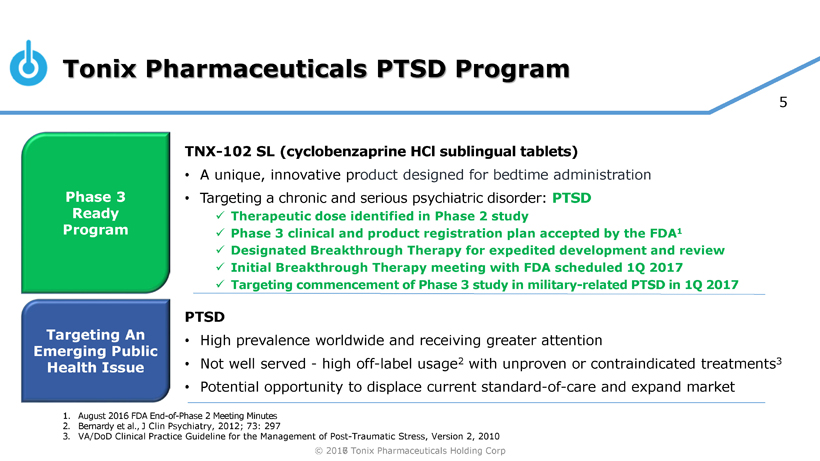
Tonix Pharmaceuticals PTSD Program Phase 3 Ready Program TNX-102 SL (cyclobenzaprine HCl sublingual tablets) • A unique, innovative product designed for bedtime administration • Targeting a chronic and serious psychiatric disorder: PTSD Therapeutic dose identified in Phase 2 study Phase 3 clinical and product registration plan accepted by the FDA1 Designated Breakthrough Therapy for expedited development and review Initial Breakthrough Therapy meeting with FDA scheduled 1Q 2017 Targeting commencement of Phase 3 study in military-related PTSD in 1Q 2017 Targeting An Emerging Public Health Issue PTSD • High prevalence worldwide and receiving greater attention • Not well served - high off-label usage2 with unproven or contraindicated treatments3 • Potential opportunity to displace current standard-of-care and expand market 1. August 2016 FDA End-of-Phase 2 Meeting Minutes 2. Bernardy et al., J Clin Psychiatry, 2012; 73: 297 3. VA/DoD Clinical Practice Guideline for the Management of Post-Traumatic Stress, Version 2, 2010 © 2016 2017 Tonix Pharmaceuticals Holding Corp

PTSD characteristics • Unmet medical need • PTSD is a serious condition and the prevalence is increasing, especially combat PTSD • Military-related PTSD is not satisfactorily treated by existing FDA approved therapies • Two selective serotonin reuptake inhibitors (SSRIs) are approved for PTSD, but have not shown efficacy in military-related PTSD • Endpoint • TNX-102 SL 5.6 mg had significant effects on the FDA-recognized primary endpoint, the Clinician-Administered PTSD Scale for DSM-5, “CAPS-5” • Potential development and partners • Several companies have U.S. psychiatry-focused specialty sales forces • Department of Defense (DoD) is interested in military-related PTSD and has the capacity to support basic science and clinical development • Important target population • U.S. veterans are in great need of a medicine that works for this serious condition © 2017 Tonix Pharmaceuticals Holding Corp

Breakthrough Therapy designation • FDA granted TNX-102 SL Breakthrough Therapy designation – reported December 19, 2016 • PTSD is a serious condition • TNX-102 SL has the potential to have advantages over existing therapies in military-related PTSD • Benefits of Breakthrough Therapy designation • Eligibility for priority review of the New Drug Application (NDA) within 6 months instead of 10 months • Option to submit completed portions of the NDA for rolling review • An organizational commitment involving FDA's senior managers to accelerate the development and approval process, an opportunity to compress development time © 2017 Tonix Pharmaceuticals Holding Corp
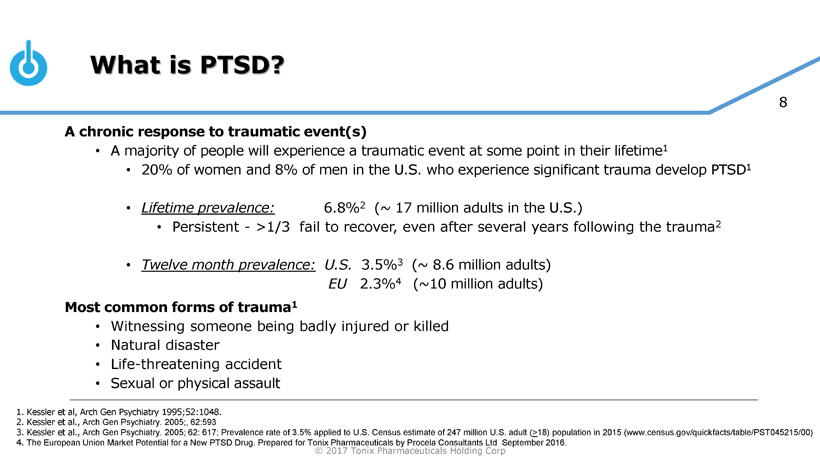
What is PTSD? A chronic response to traumatic event(s) • A majority of people will experience a traumatic event at some point in their lifetime1 • 20% of women and 8% of men in the U.S. who experience significant trauma develop PTSD1 • Lifetime prevalence: 6.8%2 (~ 17 million adults in the U.S.) • Persistent - >1/3 fail to recover, even after several years following the trauma2 • Twelve month prevalence: U.S. 3.5%3 (~ 8.6 million adults) EU 2.3%4 (~10 million adults) Most common forms of trauma1 • Witnessing someone being badly injured or killed • Natural disaster • Life-threatening accident • Sexual or physical assault 1. Kessler et al, Arch Gen Psychiatry 1995;52:1048. 2. Kessler et al., Arch Gen Psychiatry. 2005;, 62:593 3. Kessler et al., Arch Gen Psychiatry. 2005; 62: 617; Prevalence rate of 3.5% applied to U.S. Census estimate of 247 million U.S. adult (>18) population in 2015 (www.census.gov/quickfacts/table/PST045215/00) 4. The European Union Market Potential for a New PTSD Drug. Prepared for Tonix Pharmaceuticals by Procela Consultants Ltd September 2016. © 2017 Tonix Pharmaceuticals Holding Corp

What Are the Symptoms of PTSD? Symptoms of PTSD fall into four clusters: 1. Intrusion (aversive memories, nightmares, flashbacks) 2. Avoidance (avoiding persons, places or situations) 3. Mood/cognitions (memory block, emotional numbing, detachment from others) 4. Hyperarousal (anxiety, agitation & sleep disturbance) Symptoms assessed for diagnosis, severity and treatment effect • Clinician Administered PTSD Scale ("CAPS-5") • Recognized as the standard for rating PTSD severity in clinical trials • Takes into account all four symptom clusters © 2017 Tonix Pharmaceuticals Holding Corp

What Are the Consequences of PTSD? Consequences: • Impaired daily function and substantial interference with work and social interactions • Reckless or destructive behavior • Increased health care utilization and greater medical morbidity PTSD as a risk factor for: • Depression • Alcohol or substance abuse • Absenteeism/unemployment • Homelessness • Violent acts • Suicidal thoughts and suicide Unmet Needs: • Effective therapy for populations not well served by current treatment (males, military trauma) • Alternative therapy for the majority of patients unresponsive or intolerant to current treatments • Drug therapy compatible and complementary with behavioral therapy © 2017 Tonix Pharmaceuticals Holding Corp

PTSD Prevalence and Market Characteristics Prevalent Population (U.S.) ~8.6 million1 Rx 510,000 6% No Rx 128,000 Undiagnosed 2% 6,788,000 79% Rx 872,000 10% No Rx 288,000 3% Diagnosed population Large population (~1.8 million) VeteransMajority receive drug treatment TreatedCivilians: ~75%2 in VeteransVeterans: ~80%4 Administration (VA)3,4 Civilian Population2 1. Kessler, et al., 2005; ; Prevalence rate of 3.5% applied to U.S. Census estimate of 247 million U.S. adult (>18) population in 2015 (www.census.gov/quickfacts/table/PST045215/00) 2. IMS Consulting, Market Sizing & Treatment Dynamics: Post-Traumatic Stress Disorder (PTSD) Patients", 2016 3. Bowe and Rosenheck, 2015 ((638,451 veterans diagnosed with PTSD in the VA in fiscal year 2012 across all medical centers) 4. Bernardy et al., 2012 (80% of veterans diagnosed with PTSD had at least one medication from the Clinical Practice Guidelines) © 2017 Tonix Pharmaceuticals Holding Corp

What Drug Classes are Used to Treat PTSD? Market highly fragmented, with benzodiazepines being widely prescribed (but not indicated1) • Multiple medications per patient (or “Polypharmacy”) is the norm • Approximately 55% of patients receive a benzodiazepine, and 53% receive an selective serotonin reuptake inhibitor (SSRI) • SSRIs are the only FDA approved drug class Estimated PTSD Market Volume (Civilian Population Only) ~14.1 million TRx*2 Tricyclic Antidepressants Adrenergic Agents All Others Non-benzodiazpepine Hypnotics Benzodiazepines Serotonin and norepinephrine 2.84 M TRx reuptake inhibitors Other Antidepressants SSRIs 2.84 M TRx Atypical Antipsychotics Anticonvulsants/Mood Stabilizers * TRx = Total prescriptions 1. VA/DoD Clinical Practice Guideline for the Management of Post-Traumatic Stress, Version 2, 2010 2. IMS Consulting, Market Sizing & Treatment Dynamics: Post-Traumatic Stress Disorder (PTSD) Patients”, 2016 © 2017 Tonix Pharmaceuticals Holding Corp

Relevance of Sleep Disturbances for PTSD Sleep disturbances: • Core symptom of PTSD (component of intrusion and hyperarousal symptom clusters) • Believed to play roles in the pathophysiology of PTSD om Sleep Pharmacological Therapeutic As a Core Pathophysiology Action Benefit Symptom 2o Clinical 1o Clinical Endpoint Endpoint Stress Hyperarousal Sleep Disturbances PTSD • Nightmares Reduced Reduced PTSD • Hyperarousal Hyperarousal and hypervigilance interfere with sleep hyperarousal symptoms and and emotional memory processing during sleep disability © 2017 Tonix Pharmaceuticals Holding Corp

TNX-102 SL: Innovative and Unique By Design Active Pharmaceutical Ingredient (API) is cyclobenzaprine (CBP), is structurally related to tricyclic antidepressants (TCAs) • TCAs and their metabolites differ widely in their receptor binding and pharmacokinetic profiles1 • CBP is more selective for high affinity sites believed to have a role in sleep quality2 • 5-HT2A • 1-adrenergic Different • from other histamine H1 • CBP undergoes extensive first-pass hepatic metabolism when administered orally tricyclics • Major metabolite, norcyclobenzaprine (nCBP) • Long half-life (~72 hours) • Less selective for target receptors (5-HT2A, histamine H1) • More selective for norepinephrine transporter TNX-102 SL: Innovative sublingual formulation of CBP Different • Rapid systemic exposure from oral CBP • Increased bioavailability formulation • Avoids first-pass metabolism • Lowers exposure to long-lived active major metabolite, nCBP 1. Rudorfer and Potter, Cellular and Molecular Neurobiology, 1999 19:373 2. Daugherty et al., Abstract 728, Society of Biological Psychiatry 70th Annual Scientific Convention, May 14-16, 2015,Toronto, Ontario, Canada © 2017 Tonix Pharmaceuticals Holding Corp

Why Initially Target Military-Related PTSD? Military-related PTSD not well-served by existing FDA-approved therapies • No clear treatment response observed in U.S. military population Sertraline: failed to show efficacy in a large multicenter trial in U.S. military (placebo numerically better)1 Paroxetine: no large trials conducted with predominantly military trauma • Inconsistent treatment response observed in males Sertraline: FDA-conducted post-hoc analysis concluded no effect for male civilian subgroup2 Paroxetine: no sex-related difference in treatment outcomes3 • Important tolerability issues with SSRIs in this population Sexual dysfunction2,3 Insomnia2,3 SSRI withdrawal syndrome4 1. Friedman et al., J Clin Psychiatry 2007; 68:711, 2. Zoloft Package Insert, August, 2014, 3. Paxil Package Insert, June, 2014, 4. Fava et al., Psychother Psychosom 84:72-81, 2015 © 2017 2016 Tonix Pharmaceuticals Holding Corp

Phase 2 AtEase Study in Military PTSD • Randomized, double-blind, placebo- • Enrolled patients with baseline controlled trial in military-related PTSD CAPS-5 29 • Analysis from 231 patients; 24 U.S. clinical sites TNX-102 SL at bedtime once-daily • TNX-102 SL was active at 5.6 mg dose 2.8 mg N= 90 TNX-102 SL at bedtime once-daily • Primary efficacy analysis: 5.6 mg (2 x 2.8 mg) N= 49 • Difference in CAPS-5 score between TNX-102 SL 2.8 mg and placebo at week 12 Placebo at bedtime once-daily N= 92 12 weeks open-label extension © 2017 Tonix Pharmaceuticals Holding Corp

AtEase Study Demographics and Characteristics 93% of the randomized patients were male 98% had trauma during military service Deployed an average of 2.3 times Mean time since index trauma was 7 years Race and ethnicity generally consistent with U.S. military distribution Current Major Depressive Disorder 14% by MINI 7.0 Similar baseline CAPS-5 scores and MADRS scores across treatment arms Placebo TNX-102 SL 2.8 mg TNX-102 SL 5.6 mg Overall Variable N=92 N=90 N=49 N=231 Baseline CAPS-5 Scores (SD) 39.5 (7.7) 39.5 (8.0) 39.3 (8.1) 39.5 (7.85) Baseline MADRS Scores (SD) 17.3 (6.5) 17.6 (5.2) 16.1 (5.5) 17.1 (5.83) CAPS-5, Clinician Administered PTSD Scale for DSM-5 MADRS, Montgomery-Åsberg Depression Rating Scale MINI 7.0, Mini-International Neuropsychiatric Interview, version 7 SD, standard deviation © 2017 Tonix Pharmaceuticals Holding Corp

AtEase Study: Traumas Associated with PTSD Index Trauma During Military ServicePatient Count* Being involved in an IED explosion or suicide bombing 35 Witness death or injury of fellow soldiers 33 Witnessing IED explosion 30 Receiving incoming artillery, rocket, or mortar fire 29 Being wounded or injured 10 Being responsible for the death of a noncombatant 9 Witness suicide-related deaths or injury 9 Seeing ill or injured women or children you were unable to help 9 Witnessing death or injury of civilians 8 Handling or uncovering human remains 7 Sexual assault 6 Involved in serious vehicular accident (Humvee, helicopter, plane) 6 Shooting or directing fire at the enemy 5 Knowing someone seriously injured or killed 4 Being responsible for the death of an enemy combatant 4 Seeing dead bodies or human remains 4 Other 11 *Some patients experienced more than one trauma © 2017 Tonix Pharmaceuticals Holding Corp

Assessment Domain Analysis p-Values 2.8 mg (N=90) 5.6 mg (N=49) CAPS-5 Total MMRM 0.259^ 0.053 Total MMRM with Multiple Imputation 0.211 0.031* Total MMRM w/ Hybrid LOCF/BOCF 0.172 0.037* Total ANCOVA 0.090 0.038=" CAPS-5 clusters/items Arousal & Reactivity cluster (E) MMRM 0.141 0.048* Sleep item (EG] MMRM 0.185 0.010“ Exaggerated Startle item (E4) MMRM 0.336 0.015“ CGI-1 Responders Logistic Regression 0.240 0.041* PGIC Mean score MMRM 0.075 0.035“ Sheehan Disability Scale Work/school item MMRM 0.123 0.050* Social/leisure item MMRM 0.198 0.031* BQCF, baseline observation carried forward; CGI-I, Clinical Global Impression - Improvement scale; LQCF, last observation carried forward; MMRM, mixed model repeated measures; PGIC, Patient Global Impression of Change ^Primary analysis p-value net significant comparing TNX-102 SL 2.Q mg versus placebo *p-=0.Q5 © 2017 Tonix Pharmaceuticals Holding Corp

AtEase Study: Safety and Tolerability Profile No serious adverse events reported with TNX-102 SL deemed related to treatment Placebo TNX-102 SL 2.8 mg TNX-102 SL 5.6 mg Systemic Adverse Events* (N=94) (N=93) (N=50) Somnolence 6.4% 11.8% 16.0% Dry Mouth 10.6% 4.3% 16.0% Headache 4.3% 5.4% 12.0% Insomnia 8.5% 7.5% 6.0% Sedation 1.1% 2.2% 12.0% Administration Site Reactions* Hypoaesthesia oral 2.1% 38.7% 36.0% Paraesthesia 3.2% 16.1% 4.0% Glossodynia 1.1% 3.2% 6.0% Trial completion rates: 73% placebo; 79% TNX-102 SL 2.8 mg; 84% TNX-102 SL 5.6 mg *at rates of >5% in either drug-treated arm, Safety population N=237 © 2017 Tonix Pharmaceuticals Holding Corp

AtEase: Retrospective Analysis for TNX-102 SL 5.6 mg Prior pharmacotherapy trials in PTSD used earlier versions of CAPS (e.g. CAPS-2) • Different scoring range from CAPS-5 • Most frequently used a score of 50 for entry (similar to CAPS-5 331) • FDA has accepted this higher entry criteria (CAPS-5 33) for Phase 3 program Compared CAPS-5 Severity Entry Criteria 29 versus 33 on Effect Size for AtEase • Retrospective analysis showed more robust effect with high entry criteria * MMRM, mixed-effects model repeated measures, p<0.05 1Sullivan, Gregory, et al. Poster session presented at: Military Health System Research Symposium (MHSRS) 2016 Annual Meeting; 2016 Aug 15-18; Kissimmee, FL. URL: http://bit.ly/2bFo4mx © 2017 Tonix Pharmaceuticals Holding Corp
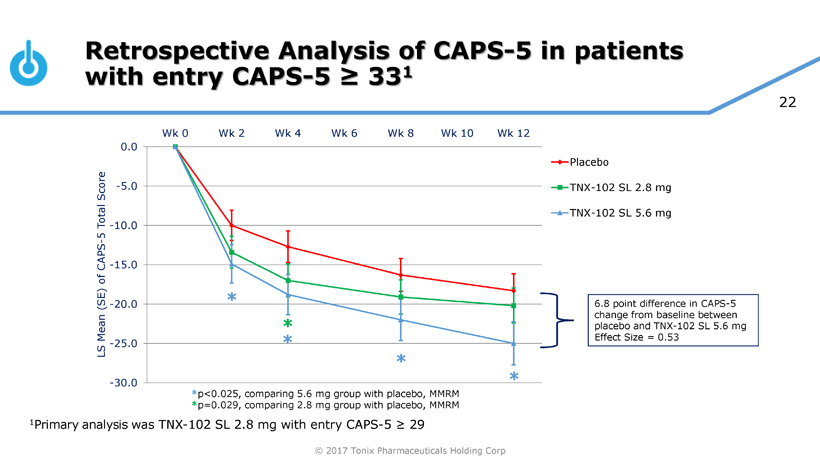
Retrospective Analysis of CAPS-5 in patients with entry CAPS-5 ≥ 331 -30.0 -25.0 -20.0 -15.0 -10.0 -5.0 0.0 Wk 0 Wk 2 Wk 4 Wk 6 Wk 8 Wk 10 Wk 12 LS Mean (SE) of CAPS-5 Total Score Placebo TNX-102 SL 2.8 mg TNX-102 SL 5.6 mg 6.8 point difference in CAPS-5 change from baseline between placebo and TNX-102 SL 5.6 mg Effect Size = 0.53 * * * * * *p<0.025, comparing 5.6 mg group with placebo, MMRM *p=0.029, comparing 2.8 mg group with placebo, MMRM 1Primary analysiswas TNX-102 SL 2.8 mg with entry CAPS-5 ≥ 29 © 2017 Tonix Pharmaceuticals Holding Corp

© 2017 Tonix Pharmaceuticals Holding Corp 23 Retrospective Analyses of Week 12 outcome measures for TNX-102 SL 5.6 mg vs. placebo in military-related or combat PTSD subset and for CAPS-5 ≥ 29 and CAPS-5 ≥ 33 at baseline Military-relatedPTSD CombatPTSD CAPS-5 at Baseline ≥ 29 ≥ 33 ≥ 29 ≥ 33 N:PBO/TNX-102 SL 5.6 mg 92/49 77/38 74/46 64/35 Outcome Measure p-value1 p-value1 p-value1 p-value1 CAPS-5 Total score 0.053 *0.013 *0.037 *0.013 Cluster B (intrusion) 0.161 *0.026 0.183 *0.031 Cluster C (avoidance) 0.963 0.522 0.824 0.570 Cluster D (mood/cognition) 0.062 0.065 *0.035 0.061 Cluster E (arousal and reactivity) *0.048 *0.012 *0.036 *0.012 E6 (Sleep item) *0.010 *0.013 *0.003 *0.010 E2 (Reckless/Self Destruct) 0.140 *0.012 0.178 *0.019 CGI–I (responders) *0.041 *0.042 *0.049 0.082 SDS Total Score 0.079 0.093 *0.039 *0.032 Work/School item 0.050 *0.040 *0.026 *0.015 Social/Leisure item *0.031 0.116 *0.013 *0.028 Family Life/Home Responsibilities item 0.524 0.455 0.328 0.274
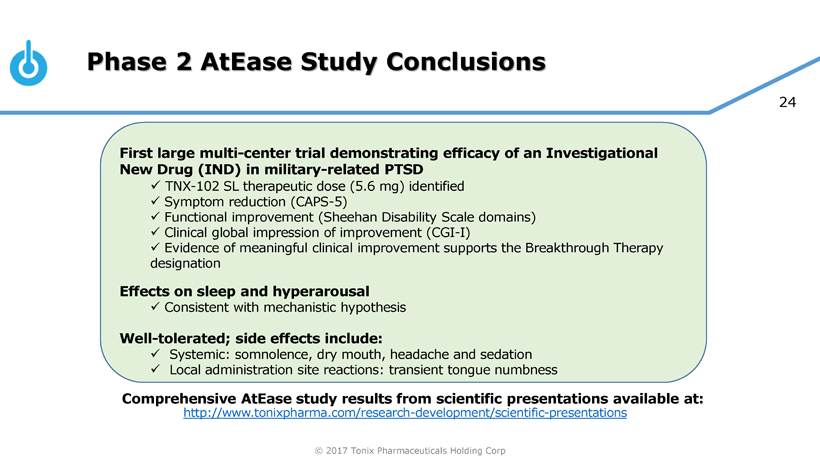
Phase 2 AtEaseStudy Conclusions First large multi-center trial demonstrating efficacy of an Investigational New Drug (IND) in military-related PTSD TNX-102 SL therapeutic dose (5.6 mg) identified Symptom reduction (CAPS-5) Functional improvement (Sheehan Disability Scale domains) Clinical global impression of improvement (CGI-I) Evidence of meaningful clinical improvement supports the Breakthrough Therapy designation Effects on sleep and hyperarousal Consistent with mechanistic hypothesis Well-tolerated; side effects include: Systemic: somnolence, dry mouth, headache and sedation Local administration site reactions: transient tongue numbness Comprehensive AtEase study results from scientific presentations available at: http://www.tonixpharma.com/research-development/scientific-presentations © 2017 Tonix Pharmaceuticals Holding Corp
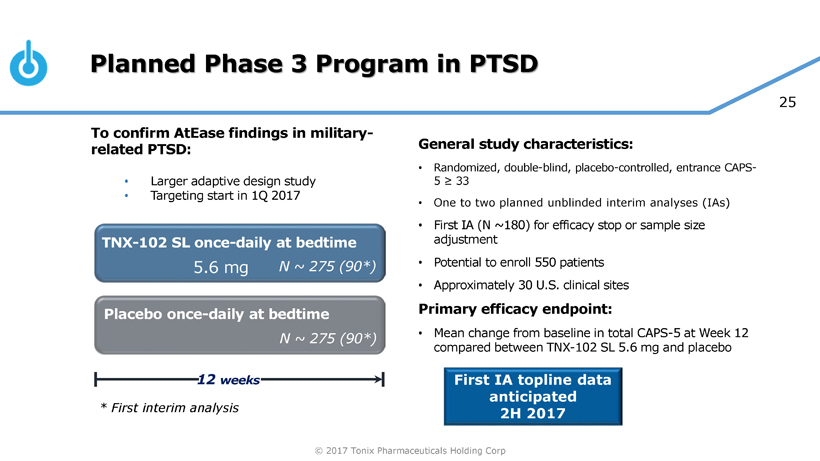
Planned Phase 3 Program in PTSD To confirm AtEase findings in military-related PTSD: • Larger adaptive design study • Targeting start in 1Q 2017 TNX-102 SL once-daily at bedtime 5.6 mg N ~ 275 (90*) Placebo once-daily at bedtime N ~ 275 (90*) 12 weeks * First interim analysis General study characteristics: • Randomized, double-blind, placebo-controlled, entrance CAPS- 5 33 • One to two planned unblinded interim analyses (IAs) • First IA (N ~180) for efficacy stop or sample size adjustment • Potential to enroll 550 patients • Approximately 30 U.S. clinical sites Primary efficacy endpoint: • Mean change from baseline in total CAPS-5 at Week 12 compared between TNX-102 SL 5.6 mg and placebo First IA topline data anticipated 2H 2017 © 2017 Tonix Pharmaceuticals Holding Corp

Commercialization Options Tonix is exploring a variety of options to commercialize TNX-102 SL, including commercializing on our own or partnering all or some indications in specific regions of the world. Commercial considerations: • Primary physician audience is well defined: psychiatrists (~30,000 in U.S.) • Small specialty sales force sufficient for coverage • Primary market research with psychiatrists indicate strong interest in new therapeutic options © 2017 Tonix Pharmaceuticals Holding Corp

Intellectual Property TNX-102 SL Portfolio of international patents filed under the Patent Cooperation Treaty (PCT) Composition-of-matter (eutectic) • Patents filed • Protection expected to 2034 Pharmacokinetics (PK) • Patents filed • Protection expected to 2033 Method-of-use • PTSD: patents filed © 2017 Tonix Pharmaceuticals Holding Corp

Product Pipeline Preclinical Phase 2 NDA/BLA Market Candidate Indication Phase 3 TNX-102 SL PTSD 505(b)(2) Phase 2 results reported May, 2016 PTSD TNX-601 505(b)(1) Novel polymorph and salt discovered and characterized TNX-801 Biologic Novel virus vaccine discovered and characterized Smallpox vaccine Cyclobenzaprine HCl sublingual tablets Tianeptineoral formulation Live virus vaccine from cell culture Registration Plan Phase 1 Animal Rule applicable MCM (Medical countermeasure) eligible for Priority Review Voucher First time approval in the U.S., leverage ex-U.S. experience New route of administration and new indication expected to enroll 1Q 2017 © 2017 Tonix Pharmaceuticals Holding Corp

TNX-601- A Potential Clinical Candidate for PTSD TNX-601 (tianeptine oral formulation) • Targeted as the 1st line monotherapy for PTSD: daytime dosing Leverages expertise in PTSD (clinical and regulatory experience, market analysis, etc.)Mechanism of Action (MOA) is different from TNX-102 SL Preclinical • Active ingredient approved in EU, Russia, Asia and Latin America for depression with established post-marketing experience Program • Reformulate using identified a new salt polymorph with improved pharmaceutical properties Filed patent application on novel salt polymorph • Issued patent on steroid-induced cognitive impairment and memory loss issues • GMP synthesis developed • IND-enabling nonclinical studies and formulation development can proceed simultaneously Clinical evidence for PTSD Targeting An • Several studies have shown tianeptine to be active in the treatment of PTSD1,2,3,4 Important Market • US clinical development benefited from the dose identified and dosing regimen developed ex-U.S. 1. Fran i kovi T, Sukovi Z, Janovi S, Stevanovi A, Nem i -Moro I, Ron evi -Gr•eta I, Letica-Crepulja M. Tianeptine in the combined treatment of combat related posttraumatic stress. disorder. Psychiatr Danub. 2011 Sep;23(3):257-63. PMID: 21963693 2. Rumyantseva GM(1), Stepanov AL. Post-traumatic stress disorder in different types of stress (clinical features and treatment). Neurosci Behav Physiol. 2008 Jan;38(1):55-61. DOI: 10.1007/s11055-008-0008-0 PMID: 18097761 3. Aleksandrovski IuA, Avedisova AS, Boev IV, Bukhanovkski AO, Voloshin VM, Tsygankov BD, Shamre BK. Efficacy and tolerability of coaxil (tianeptine) in the therapy of posttraumatic stress disorder. Zh Nevrol Psikhiatr Im S S Korsakova. 2005;105(11):24-9. PMID: 16329631 [Russian] 4. Onder E, Tural U, Aker T. A comparative study of fluoxetine, moclobemide, and tianeptine in the treatment of posttraumatic stress disorder following an earthquake. Eur Psychiatry. 2006 Apr;21(3):174-9. Epub 2005 Jun 17. DOI: 10.1016/j.eurpsy.2005.03.007 PMID: 15964747 © 2017 Tonix Pharmaceuticals Holding Corp

TNX-601- A Potential Clinical Candidate for PTSD TNX-601 (tianeptine oral formulation) • Targeted as the 1st line monotherapy for PTSD: daytime dosing Leverages expertise in PTSD (clinical and regulatory experience, market analysis, etc.)Mechanism of Action (MOA) is different from TNX-102 SL Preclinical • Active ingredient approved in EU, Russia, Asia and Latin America for depression with established post-marketing experience Program • Reformulate using identified a new salt polymorph with improved pharmaceutical properties Filed patent application on novel salt polymorph • Issued patent on steroid-induced cognitive impairment and memory loss issues • GMP synthesis developed • IND-enabling nonclinical studies and formulation development can proceed simultaneously Clinical evidence for PTSD Targeting An • Several studies have shown tianeptine to be active in the treatment of PTSD1,2,3,4 Important Market • US clinical development benefited from the dose identified and dosing regimen developed ex-U.S. 1. Fran i kovi T, Sukovi Z, Janovi S, Stevanovi A, Nem i -Moro I, Ron evi -Gr•eta I, Letica-Crepulja M. Tianeptine in the combined treatment of combat related posttraumatic stress. disorder. Psychiatr Danub. 2011 Sep;23(3):257-63. PMID: 21963693 2. Rumyantseva GM(1), Stepanov AL. Post-traumatic stress disorder in different types of stress (clinical features and treatment). Neurosci Behav Physiol. 2008 Jan;38(1):55-61. DOI: 10.1007/s11055-008-0008-0 PMID: 18097761 3. Aleksandrovski IuA, Avedisova AS, Boev IV, Bukhanovkski AO, Voloshin VM, Tsygankov BD, Shamre BK. Efficacy and tolerability of coaxil (tianeptine) in the therapy of posttraumatic stress disorder. Zh Nevrol Psikhiatr Im S S Korsakova. 2005;105(11):24-9. PMID: 16329631 [Russian] 4. Onder E, Tural U, Aker T. A comparative study of fluoxetine, moclobemide, and tianeptine in the treatment of posttraumatic stress disorder following an earthquake. Eur Psychiatry. 2006 Apr;21(3):174-9. Epub 2005 Jun 17. DOI: 10.1016/j.eurpsy.2005.03.007 PMID: 15964747 © 2017 Tonix Pharmaceuticals Holding Corp

. Tianeptinemodulates the glutamatergic system indirectlyDoes not have significant affinity (Ki>10μM) for NMDA2or AMPA3receptors . . Tianeptine is a weak μ-opioid receptor (MOR) agonistControlled substance in France, Belgium and Singapore . . Tianeptine has been shown to oppose deleterious effects of chronic stress on brain structure and plasticity . Established profile of safety from ex-U.S. use TNX-601 -A Potential Clinical Candidate for PTSD . TNX-601: Novel salt and polymorph of tianeptineImproved stability, consistency and manufacturability . Benefited from human experience established in ex-U.S. approved countries . . 5 year Hatch-Waxman exclusivity for first time approval in the U.S. . Patent filed on novel salt and polymorph Mechanism of Action Unique Characteristics of TNX-601 1. McEwen, Bruce S., et al. The neurobiological properties of tianeptine (Stablon): from monoamine hypothesis to glutamatergic modulation. Molecular psychiatry. 2010; 15.3: 237-249. 2. N-methyl-D-aspartate, 3. α-amino-3-hydroxy-5-methyl-4-isoxazolepropionic acid Active Pharmaceutical Ingredient (API) is a novel salt of tianeptineShares structural features with tricyclic antidepressants, but has unique pharmacological and neurochemical properties1 Tianeptine sodium (amorphous) is marketed for depression in Europe, Asia, Latin America –first approved in France in 1987 © 2017 Tonix Pharmaceuticals Holding Corp

TNX-801 -A Potential Smallpox Preventing Vaccine Pre-IND Candidate TNX-801 (live virus vaccine) •Targeting a biological warfare threat: smallpox xLeverages government affairs effort •Tonix has identified a new vaccine with improved properties xPatent application on novel vaccine submitted Regulatory strategy •FDA’s “Animal Rule” can be applied to establish human efficacy •GMP virus in development for human safety study Targeting An Important Market Material threat medical countermeasure (MCM) –under 21stCentury Cures Act Qualifies for receiving Priority Review Voucher on approvalPriority Review Vouchers are transferrable and have sold for >$300 M ACAM2000 developed by Acambis was acquired by Sanofi in 2008 for $513 MACAM2000 was sold to U.S. Strategic National Stockpile1 1. Nalca, A et al. ACAM2000: the new smallpox vaccine for the U.S. Strategic National Stockpile/ Drug design, development and Therapy: 4:71-79 (2010) © 2017 Tonix Pharmaceuticals Holding Corp

. Live virus vaccines stimulate cross-reactive immunityProtects from consequences of infection with variolavirus (smallpox agent) . Renders recipient “immune” and protects population (even un-immunized) by decreasing spread of infection . TNX-801 -A Potential Smallpox Preventing Vaccine . Potential safety advantage over existing vaccinia vaccinesCardiotoxicity limits use of existing vaccines . . ExclusivityPatent filed on novel virus composition . 12 years exclusivity under the Patient Protection and Affordable Care Act . Mechanism of Action Unique Characteristics of TNX-801 1. Tonix, unpublished data Active biological ingredient is live virusShares structural characteristics to vaccinia-based vaccines, but has unique virulence properties that suggest lower toxicity1 Smallpox has a ~30% mortality rate in naïve populations –vaccination discontinued in U.S. in 1970’s . © 2017 Tonix Pharmaceuticals Holding Corp

Financial overview NASDAQ: TNXP Cash, cash equivalents, and marketable $26.7 million securities reported at September 30, 2016 Net proceeds from underwritten offering in 4Q16 $4.6 million Shares outstanding (January 3, 2017) 39.2 million © 2017 Tonix Pharmaceuticals Holding Corp

Management Team Seth Lederman, MD President & CEO Gregory Sullivan, MD Chief Medical Officer Bradley Saenger, CPA Chief Financial Officer Jessica Morris EVP, Operations © 2017 Tonix Pharmaceuticals Holding Corp

Board of Directors Seth Lederman, MD Ernest Mario, PhD Chairman ALZA, Glaxo, Reliant Pharma Stuart Davidson Charles Mather Labrador Ventures, Alkermes, Combion BTIG, Janney, Jefferies, Cowen, Smith Barney Patrick Grace John Rhodes Apollo Philanthropy, WR Grace, Chemed NYSERDA, NRDC, Booz Allen Hamilton Donald Landry, MD, PhD Samuel Saks, MD Chair of Medicine, Columbia University Jazz Pharma, ALZA, Johnson & Johnson © 2017 Tonix Pharmaceuticals Holding Corp

Milestones – recent and upcoming TNX-102 SL – Posttraumatic Stress Disorder December 2015 Entered into Collaborative Research and Development Agreement (CRADA) with the United States Army Medical Materiel Development Activity (USAMMDA)May 2016 Reported results from AtEase studyAugust 2016 End-of-Phase 2 meeting with FDA - Proposed Phase 3 clinical and NDA plan acceptedDecember 2016 Breakthrough Therapy designation granted by FDA January 2017 FDA concurrence with protocol for Phase 3 study in military-related PTSD1Q 2017 FDA Initial Comprehensive Interdisciplinary Breakthrough Therapy Meeting1Q 2017 Target commencement of Phase 3 study in military-related PTSD 2H 2017 Anticipated topline data from interim analysis of Phase 3 study in ~180 military-related PTSD patients © 2017 Tonix Pharmaceuticals Holding Corp

Summary Strong position for value growth with Phase 3 trial in a major medical indication: PTSD including military-related PTSD • Phase 3 asset not previously well-known to the investor marketplace TNX-102 SL for PTSD is designated as a Breakthrough Therapy by FDA • Accelerated development and approval process is expected Funded through 1st interim analysis (180 patients) of Phase 3 PTSD trial expected to initiate in 1Q 2017 • Topline data from 1st interim analysis expected to be available 2H 2017 © 2017 Tonix Pharmaceuticals Holding Corp

NASDAQ: TNXP Thank you! © 2017 Tonix Pharmaceuticals Holding Corp
